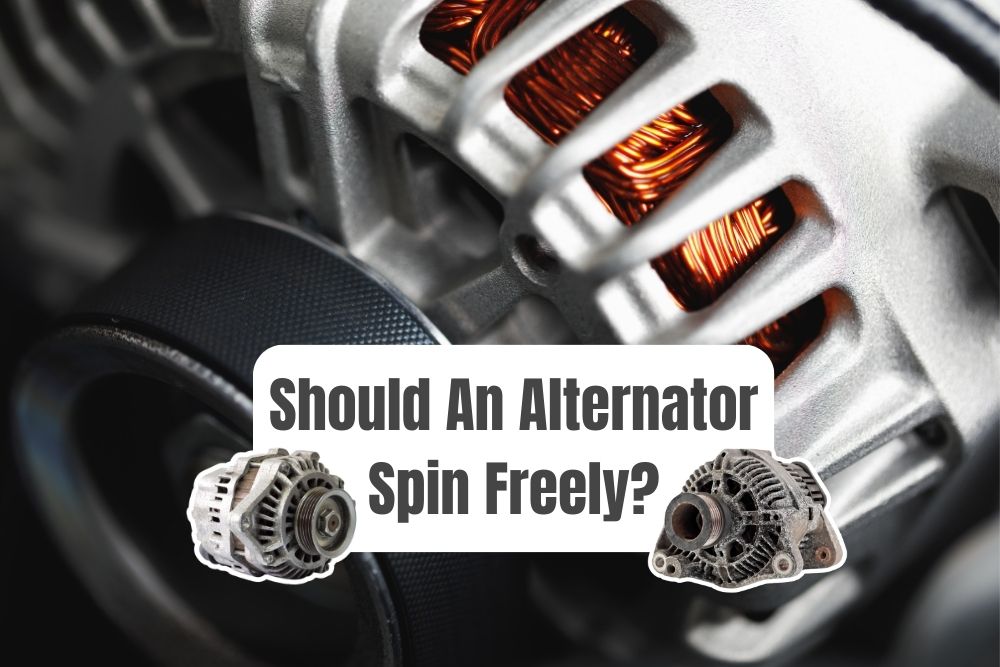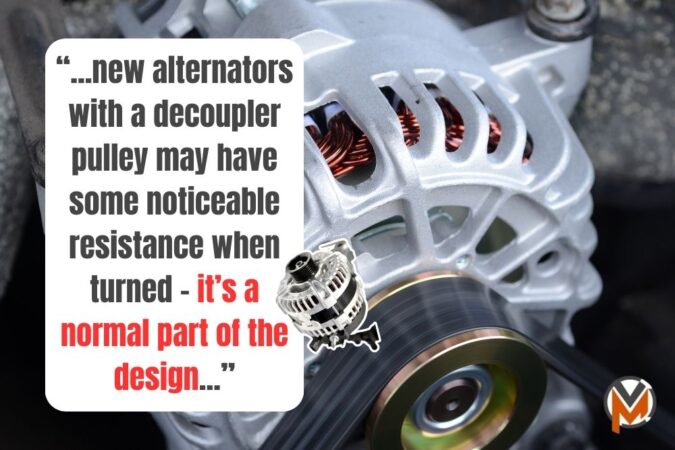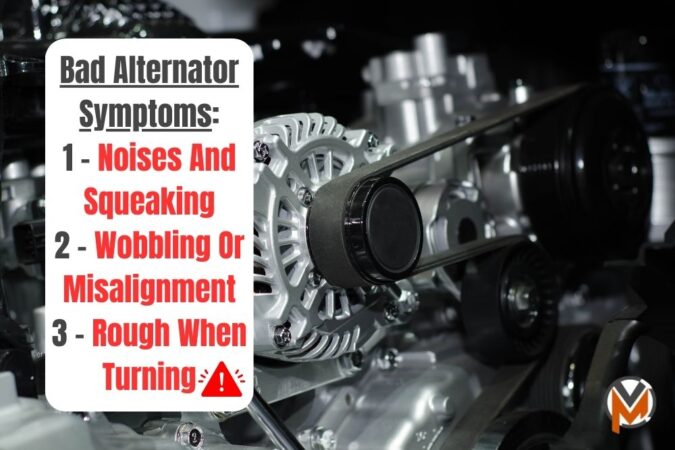When diagnosing, servicing, or installing a brand-new alternator in your car, one of the common questions that often gets asked is whether or not should an alternator spin freely, or should there be resistance?
In practice, I’ve learned, over the years, that both are true! Typically, a freely-spinning alternator that does not have any resistance is generally a good sign. This indicates that the alternator has healthy bearings.
However, it’s important to note that a tiny bit of resistance, particularly on newer or high-tech alternators that include features such as a decoupler pulley, is normal. Thus, in this case, it’s not a cause of alarm.
To help us dive a bit deeper into this topic, I’ve put together a guide here that discusses the two situations that you’ll encounter – 1) an alternator that spins freely, or 2) there’s a bit of resistance in the rotation.
- SCENARIO #1: Your alternator is free-spinning
- SCENARIO #2: The rotation has a bit of resistance
- Diagnosing alternator problems & symptoms
Scenario #1: Free-Spinning Alternator
As I mentioned earlier, a freely spinning alternator commonly signifies a well-functioning unit. This ease of movement suggests that your car’s alternator’s internal bearings are in optimal and healthy condition.
This ensures the alternator’s smooth operation without any significant friction or obstruction. Therefore, a good outcome, if you’re diagnosing your alternator, is noticing that it’s free-spinning with no resistance.
COMMUNITY & PROFESSIONAL INSIGHTS:
Besides my own experience with automotive electrics, I asked around other car enthusiasts and experts on forums and other discussion sites that often discuss the importance of a free-spinning alternator.
They all unanimously agreed that if the alternator spins without resistance when the engine is off, and the serpentine belt is removed… This is a good indication that your car’s alternator is functioning correctly.
TESTING THE FREE-NESS OF THAT SPIN:
To test this, you can manually rotate your alternator pulley. It should turn smoothly and freely without any grinding noises or hitches. This test is a simple yet effective way to gauge the health of your alternator.
Scenario #2: Some Resistance In The Rotation
Once again, it’s important to note that some level of resistance in your alternator’s spin is normal and not necessarily a cause for concern. This is particularly true for alternators equipped with a decoupler pulley.
WHAT’S THE FUNCTION OF THE DECOUPLER PULLEY:
Earlier, I mentioned the ‘decoupler pulley’ when relating to newer features found on some alternators… So, what is this thing? Well, the decoupler pulley is made to reduce vibrations and stress on the belt system.
It does this by allowing a slight ‘give’ in the alternator’s rotation. This is then perceived as resistance when manually spinning the pulley. If you’re dealing with a newer alternator, be wary that this can be normal.
EXPERT & PROFESSIONAL OPINIONS:
In discussions on automotive forums and other community threads, many experienced car enthusiasts and mechanics alike note that newer alternators can have a bit of inherent resistance in the rotation.
That is especially so for alternators with advanced features like a decoupler pulley; they have a noticeable resistance when turned by hand. This resistance is part of the design and does not indicate a problem.
ASSESSING RESISTANCE OF THE PULLEY & BEARING:
When assessing the resistance of the alternator pulley and bearings, it’s vital to differentiate between the normal amount of resistance offered by a decoupler pulley and the resistance that indicates a problem.
The latter situations might include issues like a failing bearing or a seized alternator. If the resistance feels excessively high or is accompanied by grinding noises, it’s advisable to have the alternator diagnosed.
Symptoms Of A Bad Alternator
So, to quickly summarise…
- 1) A freely spinning alternator is generally a good sign. This is indicative of healthy bearings, a good pulley, and the alternator’s proper functioning.
- 2) However, a bit of resistance, particularly in alternators with advanced features like a decoupler pulley, is quite normal and should not be a cause for alarm.
Understanding the difference between them can massively help to expedite the process of diagnosing your car’s alternator for faults. Or, analysing whether it’s in good shape or if it needs a service or replacement.
Speaking of, aside from determining how much resistance there is when your alternator can spin freely, it’s also worthwhile conducting further diagnostics and testing on the alternator. Here’s a quick guide…
1. Noises And Squeaking From The Alternator
Make note of unusual noises emanating from the alternator! These are often early indicators of potential issues. Squeaking, chirping, or grinding sounds can point toward faults with the alternator or its bearings.
The aforementioned noises could be caused by a range of issues. This might include worn-out bearings, a loose or damaged serpentine/alternator belt, or perhaps internal damage within your car’s alternator.
Meanwhile, squeaking sounds from the alternator area often occur when the bearings are starting to fail. Aside from that, if you hear a grinding noise from the alternator, this may indicate severe internal wear.
I can’t stress this enough, but it’s crucial to address these odd sounds promptly. Ignoring them can lead to further damage, potentially resulting in a complete alternator failure and subsequent vehicle breakdown.
2. Performing a Visual Inspection
When performing a diagnosis, a thorough visual inspection of your car’s alternator can reveal a lot about its condition. Look for signs of physical wear, damage, or corrosion on the alternator and its connections.
Your car’s alternator pulley should be checked for any signs of unusual movement. This might include any wobbling or misalignment. These can be signs of a failing pulley or issues with the alternator shaft.
Also, while you’re here, make sure you inspect the condition of the belt that drives the alternator. Cracks, fraying, or excessive looseness can affect alternator performance and may cause additional noise.
3. Testing the Spin of the Alternator by Hand
This is the easiest way to test it, but manually spinning the alternator pulley provides valuable insights into the condition of the bearings. With the engine off and the belt removed, rotate the pulley by hand.
As you turn the alternator pulley, feel for any roughness, grinding, or excessive resistance. Such sensations could otherwise indicate that there are worn bearings or internal damage within your car’s alternator.
Compare the resistance you feel to what is typical for your vehicle’s alternator. As mentioned earlier, some degree of resistance is rather normal. This is especially so with alternators that have a decoupler pulley.
However, any significant deviation from the norm warrants further investigation. Given that the alternator is an important part of your car’s electrics, it’s vital to be observant and proactive when diagnosing this.



